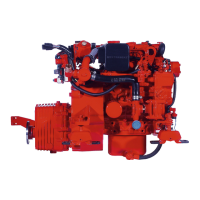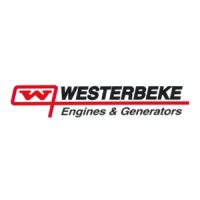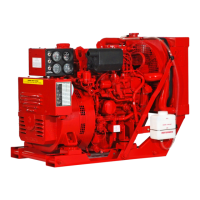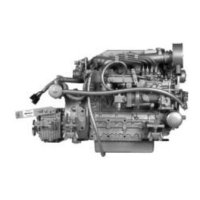DIESEL
FUEL,
ENGINE
OIL
AND
ENGINE
COOLANT
DIESEL
FUEL
USE
A
DIESEL
FUEL
WITH
A
CETANE
RATING
OF
#45
OR
HIGHER.
(No.
2·D
(SAE
J313)
diesel
fuel
according
to
ASTM
D975}.
Care
Of
The
Fuel
Supply
Use
only
clean
diesel
fuel!
The clearance of
the
components
in your
fuel
injection
pump
is
very
critical; invisible
dirt
particles
which
might
pass
through
the
filter
can
damage
these
finely
finished
parts.
It
is
important
to
buy
clean
fuel,
and
keep
it
clean.
The
best
fuel
can
be
rendered
unsatisfactory
by
careless
handling or improper storage
facilities.
To
assute that
the
fuel
gping
into
the tank
for
your
engine's
daily
use
is
clean
and
pure,
the
following
practice
is
advisable:
Purchase a
well-known
brand
of fuel.Install
and
regularly
service a
good,
visual-type
fuel
filter/water separator
between
.the
fuel
tank
and
the
engine.
The Raycor
500
MA
or
230
RMAM
are
good
examples
of
such
filters.
ENGINE
OIL
Use a
heavy
duty
engine
oil
with
an
API
classification of
CF,
CG-4,
CH-4
or CIA.
Change
the engine
oil
and
filter
after
an
initial
50
hours
of break-in operation.
Then
follow the
oil
and
filter
change
intervals
as
specified
in
the
MAINTENANCE
SCHEDULE in
this
manual.
Westerbeke
Corporation
does
not
approve
or disapprove of
the
use
of synthetic
oils.
If
synthetic
oils
are
used,
engine break-in
must
be performed
using conventional
oil.
Oil
change
intervals
must be
as
in
the
MAINTENANCE SCHEDULE, not extended because
synthetic
oils
are
used.
SAE
OILVISCOSITY
GRADES
For
all
temperatures
use
SAE
lOW-3D
or
l5W-40.
A
CAUTION:
00
not
allow
two
or
more
brands
of
engine
oil
to
mix.
Each
brand
contains
its
own
a(lditives;
additives
of
different
brands
1I0uid
reactin
the
miXture
to
produce
properties
harmful
to
your
engine.
OIL
PRESSURE
The
engine's oil pressure, during operation, is indicated
by
the
oil
pressure
gauge
on
the instrument panel. During
normal
operation,
tl,e
oil
pressure will
range
between
35
and
65
psi
2.5
and
3.9
kg/cm').
NOTE:
A newly started,
cold
engine can have
an
oil pressure
reading upwards
of60
psi (4.2 kg/cm". A warmed engine can
have an oil pressure reading as
lowas
25
psi
(1.8
kg/cm".
These readings will vary depending upon the temperature
of
the engine. the load placed
on
the engine,
and
the RPM's.
ENGINE
COOLANT
WESTERBEKE
recommends
a mixture of
50%
antifreeze
and
50%
distilled
water.
Distilled water
is
free
from
the
chemicals
that
can
corrode
internal
engine
surfaces.
The
antifreeze
performs
double
duty.
It
allows
the
engine
to
run
at
proper
temperatures
by
transferring
heat
away
from
the
engine
to
the
coolant,
and
lubricates
and
protects the
cooling circuit from rust and corrosion. Look for a
good
quality
antifreeze that
contains
Supplemental Cooling
Additives
(SCAs)
that
keep
the
antifreeze chemically
balanced,
crucial
to
long term
protection.
The distilled water and
antifreeze
should
be
premixed before
being
poured
into the
cooling
circuit.
PURCHASING
ANTIFREEZE
Rather
than
preparing
the
mixture,
WESTERBEKE
recommends
buying
the
premixed
antifreeze
so
that so that
when
adding
coolant
the
mixture
will
always
be
con·ect.
There
are
two
common
types
of
antifreeze, Ethylene Glycol
(green)
and
Propylene Glycol (red/purple), either can be used
but
do
not
mix
the
two
and
if
changing
from
one
to
another,
flush
the
engine
thoroughly.
Premixed antifreeze for DIESEL Engines:
Specification
#ASTM
D53456.
MAINTENANCE
Change
the
engine coolant
every
five
years
regardless of
the
number
of operating
hours
as
the
chemical
additives
that
protect
and
lubricate
the
engine
have a limited
life.
COOLANT
RECOVERY
TANK
A coolant
recovery
tank kit
is
supplied
with
each
engine
or
generator.
The
purpose
of
this
recovery
tank
is
to
allow
for engine coolant
expansion
and
contraction during
engine
operation,
without
the
loss of coolant
and
without
introducing
air
into
the
cooling
system.
This
kit
is provided .
and
must
be
installed before operating
the
engine.
NOTE:
This tank, with its short run
of
plastic hose, is best
located at or above the level
of
the engine's manifold, but it
can be located below the level
of
the engine's manifold
if
the
particular installation
makes
this
necessary.
Engines & Generators
5

